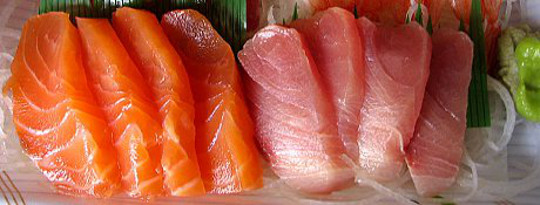
POLYCONUNDRUM - According to a study conducted by Oceana, a non-profit organization working to protect the oceans, the seafood sold in stores and restaurants in the USA is often mislabeled. You think you're buying wild salmon, but are actually eating farm-raised salmon. OK, maybe we suspected that at times... But what about when you ordered red snapper thinking that it was a healthier fish than other options, but instead were served tilefish or speckled hind.
The duplicity was worst in sushi restaurants, followed by regular restaurants, and then grocery stores. Not being a fish connoisseur, I can't tell my hind from my snapper... and apparently, 87% of red snapper buyers can't either. Out of 120 red snapper samples collected across the country, only 7 (yes SEVEN) were actually red snapper.
84 percent of the white tuna samples were actually escolar. You might say, oh, well, that's not a big deal -- fish is fish. Except that in the case of escolar, it can cause serious digestive issues for some individuals who eat more than a few ounces. And then, pregnant women who are carefully monitoring their fish intake to reduce their ingestion of mercury have been served fish with higher mercury content without their knowledge.
The report states:
Of the most commonly collected types of fish, snapper and tuna had the highest mislabeling rates across the country at 87 and 59 percent, respectively. While 44 percent of all the retail outlets visited sold mislabeled fish, sushi venues had the worst level of mislabeling at 74 percent, followed by other restaurants at 38 percent and then grocery stores at 18 percent.
“Some of the fish substitutions we found are just disturbing,” said Dr. Kimberly Warner, report author and senior scientist at Oceana. “Apart from being cheated, many consumers are being denied the right to choose fish wisely based on health or conservations concerns.”
Is there any good news in this? Well, yes! Oceana is pushing forward to require traceability of all seafood sold in the U.S.
Tracking fish from boat to plate would not only significantly reduce seafood fraud and help keep illegally caught fish out of the U.S. market, it would also give consumers more information about the fish they purchase, including the species name, where, when and how it was caught, if it was farmed or previously frozen and if any additives were using during processing.
They also recommend three steps that consumers can take:
• Ask questions. Consumers should ask more questions, including what kind of
fish it is, if it is wild or farm raised, and where, when and how it was caught.
• Check the price. If the price is too good to be true, it probably is, and you are
likely purchasing a completely different species than what is on the label.
• Purchase the whole fish. When possible, consumers can purchase the whole
fish, which makes it more difficult to swap one species for another.
For more information, read the press release which resumes some of the findings and provides a link to a map of the national testing results, or you can read the full report on the Oceana website.
























